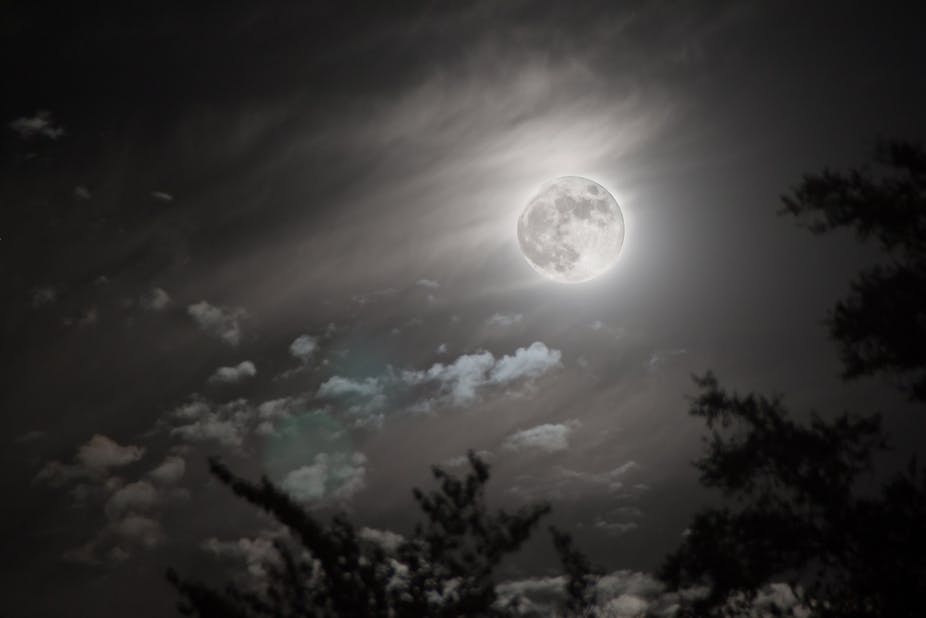A study published in the journal Nature Geoscience last week suggests water on the moon may have come, at least in part, from the sun.
Until a few years ago the orthodox view was that the moon was bone-dry. But that view underwent a sudden change in 2009.
Researchers used the Indian Chandrayan 1 spacecraft to measure sunlight reflected from the moon’s surface and found absorptions at wavelengths distinctive of water (H2O) and the related molecule hydroxyl (OH).
(Different materials reflect different wavelengths of light and by determining the wavelengths that are absorbed, researchers can determine which compounds – in this case water and hydroxyl – the light is reflecting off.)
The Chandrayan 1 findings were confirmed by re-analysis of data from the Deep Impact and Cassini spacecraft.
Then, in November that year, NASA’s LCROSS spacecraft was deliberately crashed into the polar regions of the moon and observations revealed the presence of water in the plume of material ejected.
A fluid definition
When we talk about water on the moon it does not mean there is liquid water in pools or rivers on the surface. Because the moon has no atmosphere, liquid water is not stable.
Most of the water is probably chemically bound with the minerals that make up the surface material as so-called water of hydration.
Water could also exist in the form of ice, but ice can only be stable in certain craters in the polar regions of the moon where it would be in permanent shadow.
Furthermore, the amounts of water detected are relatively small. The presence of water is, nevertheless, important as a possible resource for future space missions.
Looking for the source
So where does the water come from? Two main theories have been suggested.
Water could be delivered to the moon by the impacts of meteorites and comets, which can contain large amounts of ice.
Another theory is based on the fact hydrogen atoms reach the moon as a result of the solar wind – the continuous stream of particles ejected from the sun. The theory goes that hydrogen atoms then react with oxygen in the surface minerals to form water and hydroxyl.

The new study, published by Yang Liu from the University of Tennessee and colleagues, seeks to distinguish between these two theories by looking at the isotopic composition of the hydrogen.
Hydrogen can occur in two forms (or isotopes): normal hydrogen (with an atomic mass of 1 – one proton) and deuterium or heavy hydrogen (with an atomic mass of 2 – one proton and one neutron). The relative amount of deuterium to normal hydrogen provides a clue to the material’s origin.
The ice in comets and meteorites contains relatively large amounts of deuterium. However the hydrogen in the solar wind contains no deuterium, since all the sun’s deuterium was used up in nuclear reactions early in its history.
Apollo to the rescue
The remote-sensing observations of the moon that were used to discover its water and hydroxyl content (as discussed above) cannot distinguish between the two hydrogen isotopes. To measure isotopic composition requires accurate measurements of samples in a laboratory.
Fortunately we have lunar material here on Earth in the form of the samples collected by the astronauts from six Apollo missions from 1969 to 1972. It is these samples that were used in the current study.
The researchers detected the presence of hydroxyl in samples of lunar soils from three of the Apollo missions and measured their isotopic composition.
They found surprisingly low amounts of deuterium; in most cases less than is found in Earth’s water and much less than is observed in comets.
Liu and co-authors conclude that a substantial amount of the hydrogen in lunar water must therefore have come from the sun via the solar wind.
They also suggest the same process could operate on other airless bodies in the solar system including the asteroid Vesta, which has also shown evidence for water in observations by NASA’s Dawn spacecraft.
The water produced by these processes could, in the future, prove invaluable for astronauts travelling to the moon and beyond. As well as providing hydration itself, water can be split into its components giving oxygen to breathe and hydrogen for use as fuel.
A local source of these resources would save the huge costs of transporting these materials from Earth … assuming a moon base ever comes about.

